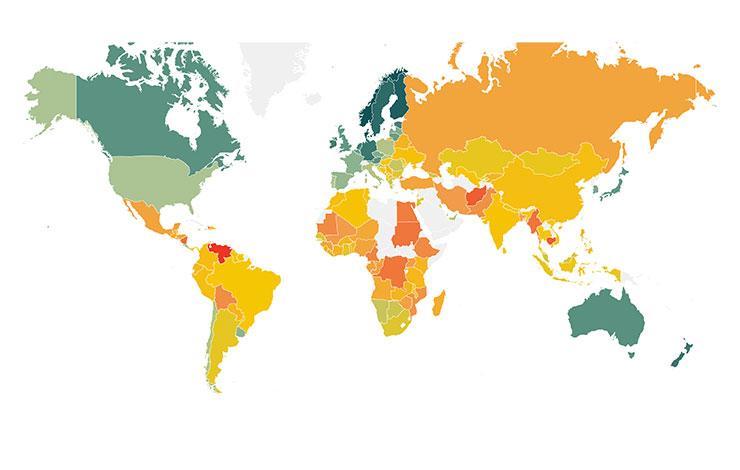

This post first appeared in a newsletter containing news, analysis and commentary articles produced by Aidspan about The Global Fund and related issues. The commentary appears in Justice Rising with permission of the authors.
For nearly a decade, China was one of the largest recipients of grants from the Global Fund for its fight against AIDS, TB and malaria. From 2003-2012, more than $805 million was disbursed to support 15 grants, nearly half of which (46%) contributed to prevention, diagnosis and treatment campaigns for TB across the country.
Once active in more than two-thirds of China’s counties and districts, the Global Fund was the largest international health partner in the country. But the shift at the Fund towards targeting resources to poorer countries with higher burdens of disease, as well as the global trend that is pushing emerging economies to shoulder an ever larger responsibility for their own health budgets, has meant an end to the fruitful partnership between China and the Fund. Just two grants remain active: one in TB and one in malaria, working along the border with Myanmar, and China was not deemed eligible in 2014 to apply for future grants.
In a paper published on March 31 by the Council on Foreign Relations, the end of the relationship brings with it an inevitable scrutiny of what has been a deeply mixed legacy. While the Fund's money made important contributions to China’s fight against the three diseases, and helped improve domestic health governance across ideational, institutional and policy domains, grant performance was uneven and there was low value for money. Most troubling were the unintended effects on civil society–building and enduring challenges to scaling-up and sustainability.
The mixed legacy has important implications for global health governance, the Fund’s future financing model, and China’s handling of its own public health challenges.
Global Health Governance
By tying a recipient country’s international reputation and resource needs to external commitments, global health institutions can make a difference in the target country’s public health status and domestic health governance.
To make the interventions effective, however, an integrated, system-wide approach is essential. Vertical, disease-specific interventions should be pursued only if they can have an impact on other programs, or if there is strong potential to reach scale. Single-minded efforts to shoehorn interventions into a one-size-fits-all approach, in relation to such things as civil society-building, may lead to unintended, undesirable outcomes that only undermine the long-term effectiveness of those programs.
By trying to impose global health norms and practices on country-specific contexts, outside actors sometimes upset the delicate balance that is so necessary to achieve success. There is a need for flexibility in implementation at the national level so that national principles and values are not compromised.
But while a cookie-cutter approach will not recognize differences between countries, conversely, overemphasizing national ownership can leave room for forces that defeat the very purpose of international intervention. A politically savvy and productive strategy would entail improved communication between the target governments and global health institutions. To that end, international health institutions should learn to conduct effective health diplomacy and to negotiate with their counterparts in a manner that is simultaneously candid, nuanced, and practical. Lack of effective communication over the issue of civil society and the fund misuse in China, for example, contributed to a soured relationship between China and the Fund. In contrast, quiet and active diplomatic efforts from the Fund leadership led to positive response from China on working with the Fund to improve public health status in Africa.
The Global Fund's financing model
The Global Fund’s experience in China serves as a reference point for the work of the relatively young institution in other countries.
The transition to the new funding model (NFM) demonstrates that the old approach of “raising the money, spending it, proving the money’s worth, and raising more money” incurs significant opportunity costs and, with its emphasis on quantifiable indicators, may create all kinds of moral hazards.
The Global Fund should place more emphasis on responding to a country's actual disease burden, ensuring program quality, and creating effective co-funding mechanisms. When dealing with recipient countries in the implementation stage, the Fund should take a more long-term view in applying its standards, values, and processes -- particularly when the recipient nation confronts serious capacity challenges.
Since the absence of country offices restricts its direct control of in-house monitoring and evaluation systems, the Fund should also train its portfolio managers not as bankers pulling the strings thousands of miles away, but as global health diplomats who have a keen understanding of each country’s internal dynamics and are skilled at cutting deals efficiently. It is imperative that the Global Fund work closely with countries transitioning out of Fund projects to develop a coherent, flexible and gap-free exit strategy, to help them sustain and scale up what has been achieved, while encouraging them to serve as partners and donors in Global Fund investments in other countries.
Finally, it is time for the Global Fund to consider taking a broader mandate that goes beyond the three diseases in order to stay relevant in the context of shifting global burden of disease and growing momentum for universal health coverage.
China's Future
The departure of the Global Fund signals China’s transition from a recipient of foreign aid to full donor status. Rather than resist the calls to assume more international responsibilities, it is time for China to come up with a timetable for partnering with other emerging economies and multilateral aid agencies, to invest in the improvement of health status in other countries. Meanwhile, China should develop a comprehensive strategy to transition seamlessly from Fund-supported programs. The government will need to mobilize more domestic resources to fill the financing gap left by the Fund’s departure, to establish a mechanism to sustain procurement and provision of pharmaceuticals, therapies and other services, and to undertake measures to integrate the disease-specific interventions into government-resourced universal health coverage. Throughout this process, the idea of the country coordination mechanism, bringing together government and non-government stakeholders with civil society and people living with disease, should be maintained.
This is particularly important to ensure that marginalized groups, affected communities and women are engaged in decision-making, and human rights are protected, in order to enhance democratization of public health services.
Indeed, the government should seriously consider building a quasi-CCM mechanism in the post-Fund era to advise policymakers, monitor the implementation of ongoing health projects, to encourage a more open, transparent governance structure, and find solutions to conflicts of interests among civil society organizations rather than take a divide and rule strategy. CSOs should be included in the discussion and development of such a strategy. Instead of being viewed as dispensable actors or trouble-makers, they should be treated as partners and catalysts for positive change in China’s health governance. As the first step, the government should change its laws and regulations to give NGOs legal status and enable them to participate in public fundraising, advocacy, and service provision, as well as program monitoring and evaluation. In considering CSOs to be funded for service purchasing, China could borrow the Global Fund’s technical review panel (TRP) model, and make the review process more professional, independent, and transparent. In doing so, China could increase its collaboration with other Fund recipient countries and stakeholders in order to achieve a more diversified, dynamic global health governance structure.
***
Photo: Public Health in China - condoms machine/Itamar Medeiros, designative.info






